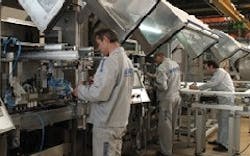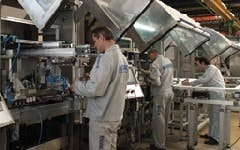Precise pneumatics aid automated assembly
How do you make millions of tiny cell phone speakers, microphones and receivers? Very carefully, and very quickly. So, either you’ll need a multitude of hands, or a few really good machines.
In the past, smaller volumes required dozens of people to manually build and check these telecom components, including the even tinier membranes and copper-wire-wound electromagnets inside them. However, Phillips Semiconductors and its former NXP Sound Solutions division in Vienna, Austria, found a couple years ago that manual assembly couldn’t keep up with surging worldwide demand and Asia’s low-cost labor.
For example, NXP previously used 78 operators to make five million speakers per year, but since has estimated it would need to employ 630 operators to produce 40 million units annually. The company calculates that it now needs a 0.6 sec cycle time to produce a speaker or receiver every 1.2 seconds on a 24/7 basis for at least 350 days per year to meet anticipated worldwide demand. Besides producing in high volumes, this system also needed flexible on/off and fast ramp-up capabilities for customized products in smaller batches.
Mikron’s G05 assembly cell provides a 100 parts per minute cycle time in NXP Sound Solution’s cell phone speaker assembly facility in Vienna.
To develop its now-automated production system, NXP turned to Mikron Assembly Technology, Boudry, Switzerland, and Festo AG in Esslingen, Germany. NXP recently installed Mikron’s G05 assembly cells, which have a 100 parts/min cycle time. Mikron in turn uses Festo’s CPV valve terminals and other pneumatic components for many of G05’s motion-control tasks, which include winding hair-thin copper wires onto spools for the magnets, gluing the coils onto membranes, and putting the speakers together.
Phillips, NXP, Mikron, and Festo reported on their ongoing assembly project during a December press tour at Phillips and NXP’s manufacturing campus in Vienna.
This facility now uses several G05 cells and 20 operators to make 72,000 8-mm Pico speakers per 12-hour shift. Automation also allows NXP to devote more manual labor to R&D, pre-development, specification conformance, pre-assembly, and sample production. In short, this means developing and perfecting automation so it can duplicate motions previously performed by humans.
Rolf Rihs, Mikron’s COO, reports that G05 is built using standard modules and units, and that it consists of a linear assembly cell that includes automatic and semi-automatic workstations, an assembly center, and feed systems that include poly-feed and palletizing devices. Though its core version was introduced in the U.S. in 2004, G05’s overall platform and accessories still are being developed.
“Besides reducing maintenance, G05’s standardized pneumatics and other parts have helped us cut our own delivery time in half to four to seven months, achieve quick reconfiguration and reusability of 60% of our components, and maintain our 100 cycle/min time,” says Rihs. Cam-driven, the G05 uses 12-18 pneumatic cylinders. Each CPV valve terminal can execute four functions on Mikron’s machines, including on/off and steering motions. Mikron requires its pneumatics to last for 50 million cycles.
Rihs adds that G05 replaced Mikron’s former Flex Cell platform, which performed many of the same tasks, but was slower, less modular, and less standardized. “We came to the limits of our old platform,” he says. “It wasn’t as modular, so we couldn’t exchange components as easily. Our users, especially NXP, need this modularity to shorten lead times and reduce time to market.
“For example, a traditional, round assembly table has 12-32 stations, but if a product’s specifications change, then you’ll need a new machine. G05’s modules can be shifted in and out easily when a product changes, which also makes reconfiguration easier.”
NXP’s production system using Mikron’s G05 has been so successful that it recently was shipped to its production facility in Beijing to serve its many Asia-based customers. The company adds that the flexibility and modularity of its system was further demonstrated by this project’s fast transfer time. NXP was able to dismantle and package its Mikron machines and the systems other components, fly them to China, and set up and start its system there in just 12 days.
Most recently, NXP has been working to automate its three lines for small, rectangular RA receivers and speakers using Mikron’s PAL standalone assembly robot. Besides using Festo’s pneumatic valves, this Mikron system includes a Keyence vision system and Siemens’ Simatic operator interface panel. This two-month-old machine is being built and installed at NXP by Fa. Manousek, a Vienna-based machine builder.


